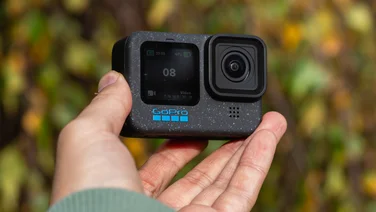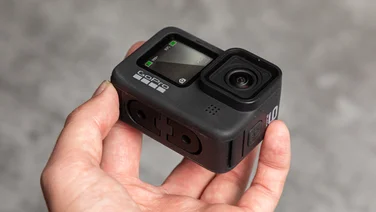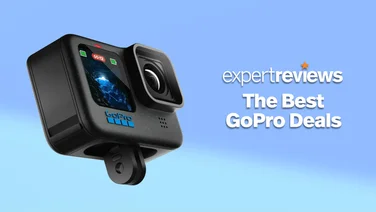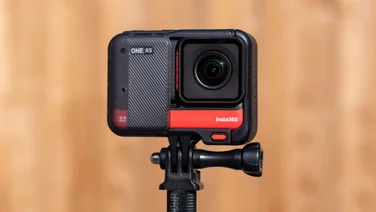To help us provide you with free impartial advice, we may earn a commission if you buy through links on our site. Learn more













- Improved heat management
- Excellent image quality
- Max Lens Mod 2.0 compatibility
- Mediocre low-light performance
- No more GPS
The GoPro Hero 12 Black is at its lowest-ever price
The Hero 12 Black is GoPro's most capable action cam yet and our favourite Hero to date. Released a few months ago with a list price of £400, Amazon is currently offering the Hero 12 Black for just £339 – its lowest price to date. If you're after a new top-flight action cam then this is a discount you won't want to miss!
£339
Amazon
The GoPro Hero 12 Black may look similar to last year’s Hero 11 – it’s near identical, in fact – but GoPro has fitted out its latest flagship with some intriguing refinements that should set it apart. Touted as “the official camera of fun”, the Hero 12 Black combines GoPro’s top-tier image quality and stabilisation tech with a more accessible user interface and improved audio options.
While the Hero 12’s headline recording specs remain unchanged from its predecessor, action cam aficionados will likely be intrigued to hear that GoPro has improved the camera’s heat management and battery life.
Refreshingly, the Hero 12 has also launched at the same price as last year’s model. In fact, as you no longer need to sign up for an annual GoPro subscription to access the best price, you could even argue it’s cheaper.
On their own these updates may seem small, but they add up to raise the Hero 12 Black above the competition.
GoPro Hero 12 Black review: What you need to know
The Hero 12 Black has the same 8:7, 1/1.9in, 27MP imaging sensor as last year’s model, allowing for easy editing of both vertical and horizontal footage. It offers 5.3K video recording at up to 60fps, 4K at up to 120fps and both 2.7K and 1080p at up to 240fps.













The Hero 12 now supports high dynamic range (HDR) video capture at up to 5.3K resolution, allowing it to capture more detail in high-contrast scenes. For those who like to grade their video footage, there’s also a new GP-Log picture mode, along with a selection of Look Up Tables (LUTS).
Arguably, the most exciting and practical update is the camera’s improved heat management and power efficiency. GoPro claims the Hero 12 offers up to double the performance of previous Hero cameras while recording in high-performance modes.The Hero 12 Black also comes with GoPro’s latest stabilisation tech, Hypersmooth 6.0. While last year’s GoPro already offered the best video stabilisation we’d seen from an action cam, this year’s model adds a revised AutoBoost setting, designed to dynamically manage how much stabilisation is applied based on your current activity.
For audio, GoPro has introduced Bluetooth support, allowing you to pair the Hero 12 with a wireless microphone or a set of AirPods, including the ability to simultaneously record audio from the internal and Bluetooth microphone onto separate audio tracks.













There are several usability additions on offer, including a new vertical capture mode, updated night effects, a stills-focused interval timer and a timecode sync function. GoPro has also decided to include a standard threaded tripod attachment point, finally.
However, there is one major backward step: GoPro has opted to omit GPS from the Hero 12, a staple of GoPro’s flagship cameras since 2016’s Hero 5, which could be a real drawback for some users.
Alongside the new Hero 12 Black, GoPro also launched the Max Lens Mod 2.0. This new Lens Mod adds the ability to record 4K60 video with an ultrawide, 177-degree field of view, and a new Max HyperView recording mode.
GoPro Hero 12 Black review: Price and competition
The GoPro Hero 12 Black launched with a list price of £400 and, unlike the last few Hero models, it’s available at that price without the need to be a GoPro subscriber.
The Hero 12’s closest rival is last year’s Hero 11 Black. It shares near-identical recording specs and can now be picked up for less, at around £350.
If you can live without the Hero 12’s 8:7 recording options, then the older Hero 10 Black makes for an incredibly capable budget option. At the time of writing you can purchase this camera for a mere £250.
GoPro may be ubiquitous in the action camera space but it’s far from the only player. DJI’s recently released Action 4 has a larger 1/1.3in sensor, giving it a notable low-light performance bump, and it comes in slightly cheaper at £379.
The Insta360 One RS is also a capable competitor. Its modular construction allows it to be kitted out as a traditional action cam or a full-blown 360 camera. The single-lens 4K kit also comes in significantly cheaper than the Hero 12 Black at £280. Image quality is substantially lower, however.
READ NEXT: The best GoPro deals
GoPro Hero 12 Black review: Features and design
The GoPro Hero 12 Black follows the same tried and tested design layout as the previous few generations of Hero. Place it next to last year’s Hero 11 Black or, indeed, the Hero 10 or 9 and you’ll struggle to notice much of a difference. The Hero 12 is identifiable by its blue splatter paint job on the front and rear, its indented rather than painted shutter button and the new tripod thread in its base.
The Hero 12 Black is constructed from a mix of hardened and rubberised plastics, with a pair of metallic mounting prongs built into its base. It measures 72 x 51 x 34mm, weighs 154g and offers 10m of native water resistance.













Arranged across the face of the device there’s a 25 x 25mm non-touch sensitive colour LCD, a microphone and the lens. The lens’s housing can be removed and replaced should it get scratched and it’s also interchangeable with either of GoPro’s Max Lens Mod accessories, should you want to achieve a wider field of view.
The rear of the camera is taken up almost entirely by a large, 50 x 33mm colour touchscreen. This display is used for the bulk of the Hero’s camera control, as well as menu navigation and video playback. It’s flanked by a small LED tally light that illuminates when the camera is recording.
Up top there’s a textured rubber shutter button and a second microphone. On the side there’s a physical mode/power button, along with a vent that hides a third microphone. This looks like a latch, but it’s actually part of a water drainage system, so you can quickly reestablish clear audio while recording around water.













On the other side is a large, water-tight door covering the microSD card slot, battery and USB-C port, and the base houses GoPro’s classic mounting prongs, a traditional 1/4in tripod thread and a speaker.
By default, the Hero 12 Black launches into a new “Easy” control mode with a simplified user interface. The Hero 12 comes with dedicated modes for photo, video and timelapse capture, and within the Easy control mode you have the ability to toggle the camera’s field of view and image quality.
More experienced GoPro users will likely want to switch to the “Pro” control mode, where you have full control over the camera’s stabilisation settings, resolutions, frame rates and the Protune capture controls.













The camera can also be controlled using GoPro’s smartphone app. Indeed, you’ll need to pair the Hero 12 with your smartphone using the app in order to complete the initial setup procedure. The GoPro app can be used for remote camera control, editing your clips, backing up your footage to the cloud and sharing your edits straight to your social media accounts.
GoPro Hero 12 Black review: Performance
Booting straight into GoPro’s new, simplified “Easy” control mode makes the Hero 12 easier to use than ever before. The onscreen icons are clearly labelled and the menus keep technical jargon to a minimum. For novices, or indeed anyone that simply wants to start recording right off the bat, this mode is going to be a very welcome addition.
A knock-on that I’m slightly less fond of, however, is that when switching over to the “Pro” control mode, GoPro has opted to strip out all its usual quick-access presets. While you can create and save your own presets from scratch, it feels like a bit of an unnecessary extra step.
Once you do have your settings dialled in, however, the GoPro Hero 12 Black is a breeze to use. You can hop between shooting modes with a few simple swipes, toggle most settings straight from the home screen and go from power off to recording in a few seconds.













Under optimal lighting conditions the GoPro Hero 12 Black is capable of recording punchy, vibrant, best-in-class video clips. The camera’s automatic white balance and exposure settings are consistent and accurate and, for most situations, simply pointing and shooting is going to give you some solid-looking results. The camera’s 5.3K recording mode offers heaps of punchy, crisp detail and the 8:7 aspect ratio gives editors plenty of real estate to work with.
Using the Hero 12’s new HDR recording mode I found it was able to retain more highlight and shadow detail in contrasty and backlit scenes. However, in some other scenes, I felt like the footage looked a little over-processed, and in flatter lighting you’re not going to gain much benefit. Additionally, it’s worth noting that toggling HDR halves your available frame rate options. Shooting 5.3K in HDR caps out at 30fps and 4K HDR is limited to 60fps, so users will have to decide when it’s worth the trade-off.
Low-light performance continues to be a weak point. Like most small-sensor cameras, the Hero 12’s image quality drops off when the light levels dip. If you want to get the most out of those 5.3K recordings, you’re going to need to stick to brightly lit scenes.













Side-by-side with footage from the Hero 11 Black, I didn’t notice a stark difference in image quality. In some scenes, the Hero 12 looked ever so slightly improved and, with HDR enabled, it had the edge on dynamic range. However, in a blind test, I think I’d struggle to consistently tell footage from the two apart.
Image stabilisation is a somewhat similar situation. The Hero 12’s HyperSmooth 6.0 stabilisation is incredible, capable of smoothing out even the jerkiest of camera movements and, thanks to its full 360-degree levelling function, it maintains a perfectly level horizon throughout. However, given the Hero 11 was already incredibly effective in this area, it feels like GoPro is reaching the limit of what’s practically achievable.
The Hero 12’s Autoboost function is a nice addition, though. During frantic movements it increases the amount of digital stabilisation – and the associated image cropping. When things calm down it reduces the stabilisation again, in turn reducing the amount of image crop and boosting quality. The transitions are smooth and, for most people, this is likely to become their default stabilisation mode.













It’s in the area of heat and power management where the Hero 12 Black really starts to set itself apart. Recording in 5.3K at 60fps I managed 47 minutes of continuous recording before the overheat protection kicked in – nearly double the 25 minutes I was able to get out of the Hero 11 Black. After cooling down I got 70 minutes of total recording out of the camera before the battery died. The Hero 11, meanwhile, ran out of juice after just 50 minutes. This represents a huge and highly practical performance increase.
The Bluetooth audio capabilities show promise but could do with a little improvement. On paper, having the ability to pair a mic over Bluetooth seems so obvious you wonder why it’s taken GoPro so long to introduce it. In practice, it doesn’t quite live up to expectations. You can’t manually adjust the audio input level and, ultimately, you’re limited by the quality of your mic. I wouldn’t be surprised if GoPro announced an accessory Bluetooth microphone soon.
Although an optional extra, I feel compelled at this point to comment on how good GoPro’s Max Mod 2.0 is when paired with the Hero 12. When attached, it expands the Hero 12’s field of view to 177 degrees. Recording is limited to 4K60, but it gives creators a fantastically wide perspective. There’s also a Max HyperView mode that squishes the full 8:7 frame down into an expansive 16:9 frame for a totally unique look.
GoPro Hero 12 Black review: Verdict
If you were hoping for a radical overhaul this year, you may be disappointed. On paper, at least, the Hero 12 looks a lot like a Hero 11 with a firmware update and a tripod mount.
In practice, however, the Hero 12 Black feels like a much refined action camera. GoPro’s image quality and stabilisation efficacy continue to be market-leading. The Hero 12’s new “Easy” control mode makes the camera more accessible – even if I am irked to lose the standard camera presets.
Compatibility with the new Max Lens Mod 2.0 accessory expands the camera’s horizons, literally. And, overall, the improvements to the camera’s heat management and battery performance make the Hero 12 Black a far more practical camera to use in the real world.
Indeed, there’s no question that the GoPro Hero 12 Black is the new action camera king. The real question for consumers will be whether the refinements are worth the premium over the now-reduced Hero 10 and Hero 11 Black cameras.











